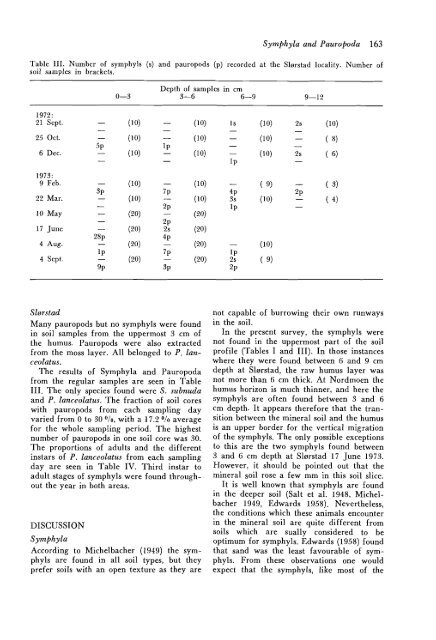Full-text - Norsk entomologisk forening
Full-text - Norsk entomologisk forening
Full-text - Norsk entomologisk forening
Create successful ePaper yourself
Turn your PDF publications into a flip-book with our unique Google optimized e-Paper software.
Symphyla and Pauropoda 163<br />
Table 111. Number of symphyls (S) and pauropods (p) recorded at the Sl~rstad locality. Number of<br />
soil samples in brackets.<br />
1972:<br />
21 Sept.<br />
25 Oct.<br />
6 Dec.<br />
Depth of samples in cm<br />
0-3 3-6 6-9 9-12<br />
1973:<br />
9 Feb.<br />
22 Mar.<br />
10 May<br />
17 June<br />
4 Aug.<br />
4 Sept.<br />
Many pauropods but no symphyls were found<br />
in soil samples from the uppermost 3 cm of<br />
the humus. Pauropods were also extracted<br />
from the moss layer. Al1 belonged to P. lanceolatus.<br />
The results of Symphyla and Pauropoda<br />
from the regular samples are seen in Table<br />
111. The only species found were S. sz~bnuda<br />
and P. lanceolatus. The fraction of soil cores<br />
with pauropods from each sampling day<br />
varied from O to 30 OJO, with a 17.2 OJO average<br />
for the whole sampIing period. The highest<br />
number of pauropods in one soil core was 30.<br />
The proportions of adults and the different<br />
instars of P. lanceolatus from each sampling<br />
day are seen in Table IV. Third instar to<br />
adult stages of symphyls were found throughout<br />
the year in both areas.<br />
DISCUSSION<br />
Symphyla<br />
According to Michelbacher (1949) the symphyls<br />
are found in al1 soil types, but they<br />
prefer soils with an open <strong>text</strong>ure as they are<br />
not capable of burrowing their own runways<br />
in the soil.<br />
In the present survey, the symphyls were<br />
not found in the uppermost part of the soil<br />
profile (Tables 1 and 111). In those instances<br />
where they were found between 6 and 9 cm<br />
depth at Slerstad, the raw humus layer was<br />
not more than 6 cm thick. At Nordmoen the<br />
humus horizon is much thinner, and here the<br />
symphyls are often found between 3 and 6<br />
cm depth. It appears therefore that the transition<br />
between the mineral soil and the humus<br />
is an upper border for the vertical migration<br />
of the symphyls. The only possible exceptions<br />
to this are the two symphyls found between<br />
3 and 6 cm depth at Slerstad 17 June 1973.<br />
However, it should be pointed out that the<br />
mineral soil rose a few mm in this soil slice.<br />
It is well known that symphyls are found<br />
in the deeper soil (Salt et al. 1948, Michelbacher<br />
1949, Edwards 1958). Nevertheless,<br />
the conditions which these animals encounter<br />
in the mineral soil are quite different from<br />
soils which are sually considered to be<br />
optimum for symphyls. Edwards (1958) found<br />
that sand was the least favourable of symphyls.<br />
From these observations one would<br />
expect that the symphyls, like most of the

















